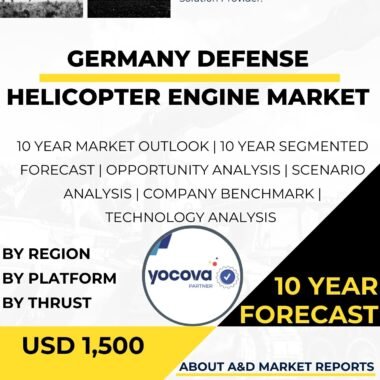Description
Malaysia Defense Turbojet Engine market has experienced significant growth in recent years, reflecting the nation’s commitment to strengthening its aerospace defense capabilities and ensuring the operational readiness of its military aircraft fleet. Turbojet engines remain essential components of fighter aircraft and other high-performance military platforms, delivering the thrust and propulsion needed for air superiority, rapid maneuvering, and advanced combat operations. By adopting next-generation turbojet technologies, Malaysia has reinforced its ability to sustain a modern and effective air force, improving its overall defense preparedness and strategic posture.
Strategic Importance of the Defense Turbojet Engine Market in Malaysia
Malaysia’s geopolitical position in Southeast Asia requires a capable air force equipped with fast, agile, and high-performance aircraft. The region’s complex security environment necessitates rapid response capabilities, air dominance, and flexible tactical options. Advanced turbojet engines empower Malaysia to maintain credible deterrence, enhance aerial combat capabilities, and effectively counter regional threats. Their role extends beyond combat, supporting patrol, interception, and deterrence missions essential to national security.
Technological Advancements in the Defense Turbojet Engine Market in Malaysia
The Malaysian market has seen notable technological progress driven by global innovation in propulsion systems. Modern turbojet engines feature:
High thrust-to-weight ratios to ensure superior acceleration and speed
Enhanced fuel efficiency for extended mission endurance
Advanced cooling systems to withstand extreme temperatures
Variable geometry nozzles for improved maneuverability and performance
Digital engine control systems (FADEC) for precise monitoring and operational optimization
These advancements enhance operational versatility, engine longevity, and mission reliability, making turbojets a vital component of Malaysia’s modern air combat strategy.
Domestic Capability Development in the Defense Turbojet Engine Market in Malaysia
Malaysia is investing in building its indigenous defense industrial base, with growing interest in local assembly, maintenance, repair, overhaul (MRO), and future engine development. Government-backed research initiatives and collaboration with educational and technical institutions aim to improve local engineering expertise, expand domestic aerospace capabilities, and reduce long-term dependence on foreign suppliers.
International Collaboration in the Defense Turbojet Engine Market in Malaysia
Global partnerships remain central to Malaysia’s propulsion modernization efforts. Collaborations with leading international engine manufacturers provide:
Access to next-generation propulsion technologies
Technology transfer and industrial cooperation
Specialized training for engineers, technicians, and pilots
Strengthening of local MRO ecosystems
These cooperative efforts accelerate Malaysia’s integration into global aerospace technology networks and fuel domestic capability growth.
Challenges in the Defense Turbojet Engine Market in Malaysia
Despite its progress, the market faces several challenges that must be addressed for continued advancement:
High Acquisition and Maintenance Costs
Turbojet engines require substantial investments not only for procurement but also for ongoing maintenance, overhaul, and logistical support.
Need for Skilled Personnel
Highly trained aviation mechanics, engineers, and pilots are essential for safe and effective engine operation. Continuous training and technical upskilling remain critical priorities.
Logistics and Spare Parts Availability
Sustaining high-performance engines demands efficient supply chains and consistent access to specialized components.
Integration and Interoperability Issues
Malaysia operates aircraft from various origins and generations. Ensuring seamless integration between airframes and engines is crucial for effective joint operations.
Future Outlook
The outlook for Malaysia’s turbojet engine market remains strong, supported by ongoing air force modernization, increased operational requirements, and growing regional defense cooperation. Future trends likely to shape the market include:
Adoption of more fuel-efficient and environmentally optimized engines
Development of hybrid or adaptive propulsion technologies
Expansion of digital diagnostics and predictive maintenance systems
Increased focus on interoperable propulsion solutions for joint and coalition operations
Malaysia’s participation in multinational exercises and defense partnerships will further influence demand for advanced, high-performance turbojet engines.
Conclusion
The Defense Turbojet Engine market in Malaysia has shown substantial growth, supported by strategic modernization efforts, technological advancements, and international partnerships. Advanced turbojet engines play an indispensable role in strengthening Malaysia’s air defense capabilities, enabling superior aircraft performance and enhancing national security.
However, challenges such as cost constraints, skill gaps, technological complexity, and system integration must be proactively managed to maintain progress. By continuing to invest in high-performance propulsion systems and domestic capability development, Malaysia is positioned to sustain a modern and capable air force equipped for evolving defense requirements.




